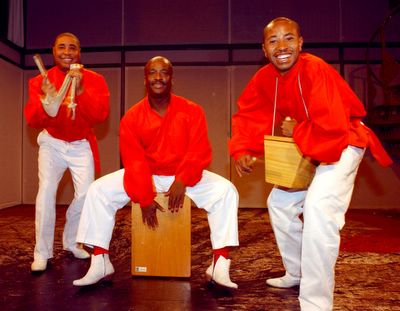5.02.2005
Perú Negro

Perú Negro's percussion section, demonstrating uniquely Peruvian instruments. Photo by Gilmar Lopez, courtesy www.perunegro.org
It's a sad history that has parallels in North America. During colonial times, African slaves in Perú were not permitted to play music using drums and other percussive instruments. So, they invented entirely new instruments using available materials, including (above, from left to right) the Quijada, the Cajón and the Cajita.
Dan Rosenberg at Afropop.org tells the history of these instruments quite wonderfully:
"In much of Africa and the Americas, scrapers and shakers are frequently made by cutting ridges into gourds, or by attaching shells to them. Black Peruvians, of course, have a different tradition. They use the quijada de burro, literally the jawbone of a donkey. They take an old jawbone from a dead donkey, let it dry out, and loosen the teeth. Then, when it is struck with the palm, it produces a wonderful shhhhh-tshhhhhh sound. Running a stick along the teeth allows it to double as a scraper. While Peru isn't the only place that uses the quijada, it is the place most strongly associated with this unusual scraper and shaker.
Flamenco fans may have seen legendary guitarist Paco de Lucia with a cajon player in his ensemble. When Paco de Lucia visited Peru nearly 20 years ago, the Spanish ambassador threw a party. Among those present was Caitro Soto, one of Peru's top percussionists. Soto gave de Lucia a cajon as a present. He also gave the guitarist basic tips on the instrument, which has now become a standard part de Lucia's flamenco ensemble. Ironically, today, many people think that the instrument is Spanish. It is 100% Peruvian.
Another one of Peru's famous musical instrument boxes is the cajita. Imagine a trapezoidal shaped box about the size of a child's jack-in-a-box. One hand opens and closes the lid while the other hits the box with a wooden stick. The cajita also had Catholic origins. It was adapted from the wooden boxes that the priests used every Sunday in church to gather the weekly collection. The result wasn't exactly what those priests had in mind."
In its performance, Afro-Peruvian music is visually stunning. The group Perú Negro offers a video sample (requires Real player) on their site. I also highly recommend David Byrne's compilation "Afro-Peruvian Classics: The Soul of Black Peru" as an easy and infectious introduction to this incredible music.




